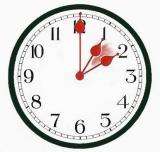March 16, 2010 report
Study: Daylight saving time a waste of energy

(PhysOrg.com) -- Daylight saving time is supposed to reduce energy use, but data gathered from a state in the US suggests it actually does the opposite.
The US state of Indiana has 92 counties, but until 2006 only 15 of them adjusted their clocks for daylight saving time, with the remainder keeping standard time all year, at least partly to appease farmers who did not want the change. Then in 2006 the Indiana Legislature decided the entire state should adopt daylight saving time, beginning that spring.
This unique situation enabled professor of economics Matthew Kotchen and his PhD student Laura E. Grant, both from the University of California at Santa Barbara, to study how the adoption of daylight saving affected energy use. They studied over seven million electricity meter readings in southern Indiana every month for three years, and compared the energy consumption before and after the change. The 15 counties that had adopted daylight saving time much earlier were the control group, which allowed them to adjust for the effects of weather extremes over the period.
The result of the study showed that electricity use went up in the counties adopting daylight saving time in 2006, costing $8.6 million more in household electricity bills. The conclusion reached by Kotchen and Grant was that while the lighting costs were reduced in the afternoons by daylight saving, the greater heating costs in the mornings, and more use of air-conditioners on hot afternoons more than offset these savings. Kotchen said the results were more “clear and unambiguous” than results in any other paper he had presented.
Kotchen and Grant's work reinforces the findings of an Australian study in 2007 by economists Ryan Kellogg and Hendrik Wolff, who studied the extension of daylight saving time for two months in New South Wales and Victoria for the 2000 Summer Olympics. They also found an increase in energy use.
Daylight saving was initially introduced, and has been extended, because it was believed to save energy, but the studies upon which this idea was based were conducted in the 1970s. A big difference between then and the present is the massive increase in the take-up of air conditioning. In hot periods daylight saving time means air conditioners tend to be run more when people arrive home from work, while in cooler periods more heating is used.
Professor Kotchen presented the paper at the March National Bureau of Economic Research conference.
More information: via WSJ
© 2010 PhysOrg.com















